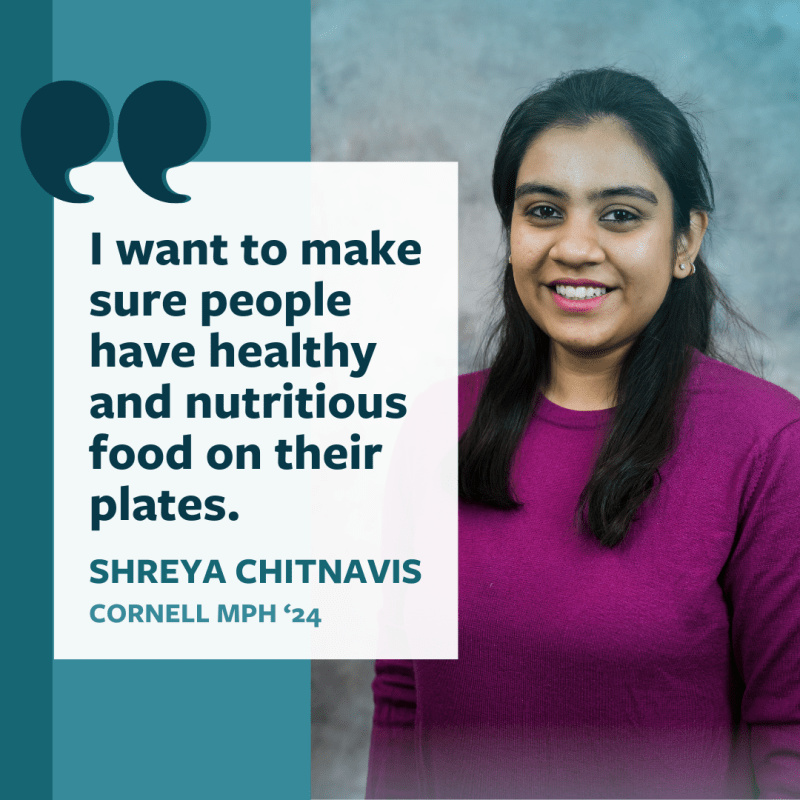Shifting food trends in rural Cambodia
 Having grown up in Chennai, a city on the southeast coast of India, Shreya Chitnavis felt “right at home” when she stepped off the plane to begin a summer internship in Phnom Penh, Cambodia—another humid, coastal city. “India and Cambodia have a lot of similarities,” she points out, including a trend where families are shifting from cooking their traditional meals at home to relying more on food away from home. As the tendency to eat ‘food-away-from-home’ increases, she explains, so does a “nutrition transition” toward more highly processed foods, which can contribute to diet-related diseases. As a result, she says, “there is a double burden of both undernutrition and overweight within the same households and populations.” This shift also makes it more difficult to provide targeted interventions.
Having grown up in Chennai, a city on the southeast coast of India, Shreya Chitnavis felt “right at home” when she stepped off the plane to begin a summer internship in Phnom Penh, Cambodia—another humid, coastal city. “India and Cambodia have a lot of similarities,” she points out, including a trend where families are shifting from cooking their traditional meals at home to relying more on food away from home. As the tendency to eat ‘food-away-from-home’ increases, she explains, so does a “nutrition transition” toward more highly processed foods, which can contribute to diet-related diseases. As a result, she says, “there is a double burden of both undernutrition and overweight within the same households and populations.” This shift also makes it more difficult to provide targeted interventions.
In Cambodia, Chitnavis joined one arm of the CGIAR Initiative on Asian Mega-Deltas, a project focused on building secure, resilient food systems in communities along the Mekong River, which flows through six countries and supports the livelihoods of millions. The project was first inspired by a survey on household consumption patterns across five provinces along the Mekong, when researchers “noticed that food vendors were important at a household level,” Chitnavis says. Since there are no large supermarkets in these rural areas, households “depend on small vendors” either passing through villages with their bikes and carts or stationed outside homes or community centers.
Chitnavis spent two weeks visiting the same five provinces, waking early in the morning to visit community leaders before traveling with a team to administer a questionnaire—translated to the local language, Khmer—to food vendors. The team interviewed 212 vendors and found that at least 60% of those interviewed sold ultra-processed sugar-sweetened or packaged foods, which are “very tempting for kids,” she notes.

Along the Mekong River, common staple foods typically include rice and fish, says Chitnavis, “but this varies based on culture, climate, and food availability.” Small-scale producers in all Asian mega-delta communities are at great risk of poverty and food insecurity due to the impacts of climate change, including increased flooding, water shortages, and extreme weather events. Chitnavis and her team suspect that locals see ultra-processed food as one solution to food insecurity, as drastic changes in monsoon patterns impact the production of traditional foods.
“This is a baseline study,” she points out, noting that further research is needed to understand more about why food-away-from-home is gaining traction in these regions. For now, Chitnavis is developing a summary report and working toward a scholarly publication. She imagines future interventions that “revive traditional food culture and educate kids about nutrition.
Chitnavis’s interest in food processing was first piqued in high school, though she realized after studying biotechnology and joining a food processing laboratory at McGill University that she “wanted a program that looked at food more holistically. When she found Cornell Public Health’s Food Systems & Health concentration, “it felt like it was made for me,” she remembers. Now, as a second year MPH student, Chitnavis sees herself continuing to “work to make the food system more sustainable in the developing and underdeveloped world.” After graduation, she wants to gain more experience in the field with international organizations like CGIAR. “I want to make sure people have healthy and nutritious food on their plates.”
Written by Audrey Baker
